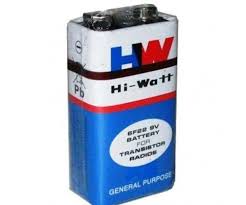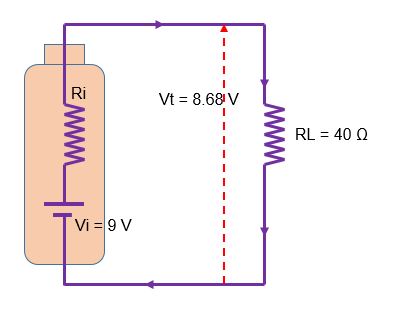Akshara Computer Center:Engineers Katta
Virtual Electronics Lab
Experiment-2 Understanding Battery Internal Resistance
Purpose of the experiment:
To understand and measure the battery internal resistance..
To understand and measure the battery internal resistance..
Theory:



Normally we expect that battery shall last for 5-10 hours. Considering this; obviously we shall try to maintain the battery current to 50 mA to 100 mA.
Apart from battery capacity; its internal resistance plays a vital role in understanding working of the battery. Due to its internal resistance battery voltage drops significantly as we tries to load them. Internal resistance of the battery depends upon type of battery, loading of battery, ambient temperature etc.
In this experiment we will try to measure the internal resistance of the common 9 V alkaline or zinc carbon battery.


These are images of commonly used 9 V batteries. They are generally used in electronic projects.
With this experiment we will try to understand about its current supplying capacity

Theoretically if the 0.1 ohms resistance is connected across the 9 volt battery
(i.e. let battery terminal shorted by wire momentarily and open as shown);
there shall be 9/0.1 = 90 ampere current (Boom $$$) previously flowing through the circuit will break .
Breaking of 90 Amp. current means very heavy spark as shown in this figure. But we know it never happens. Actually battery internal resistance limits the current.
Also we know that battery converts chemical energy into electrical energy.
Hence normally more is the size of the battery more energy is stored in it (energy stored also depends upon battery chemistry).
This stored energy of the battery is expressed in Ah capacity.
In electronics normally battery size is less it is expressed in mAh capacity.
Typically 9 V battery has the 500 mAh capacity.
That means if it is discharged at the rate of 500mA during 1 hour it will be get discharged completely.
Normally we expect that battery shall last for 5-10 hours. Considering this; obviously we shall try to maintain the battery current to 50 mA to 100 mA.
Apart from battery capacity; its internal resistance plays a vital role in understanding working of the battery. Due to its internal resistance battery voltage drops significantly as we tries to load them. Internal resistance of the battery depends upon type of battery, loading of battery, ambient temperature etc.
In this experiment we will try to measure the internal resistance of the common 9 V alkaline or zinc carbon battery.
Explaination:
 Observe the following circuit diagram which is self-explanatory. In diagram internal resistance of the battery is shown by Ri.
Observe the following circuit diagram which is self-explanatory. In diagram internal resistance of the battery is shown by Ri.
Let the load on battery be RL = 40 Ohms. And terminal voltage measured be 8.68 Volts
That means current flowing through the load resistance would be 8.68/40 = 0.217 Amp or say 217 mA (In the field of electronics it is common to express the current in mA).
9 V battery can be represented by a resistance Ri in series with 9.0 volts ideal voltage source as shown in figure.
This 217 mA (or 0.217A) current produced voltage drop of 9.0 – 8.68 = 0.32 volts across battery internal resistance (Ri).
Hence from the formula
R = V/I
Battery internal resistance would be 0.32/0.217 = 1.48 ohms
Let the load on battery be RL = 40 Ohms. And terminal voltage measured be 8.68 Volts
That means current flowing through the load resistance would be 8.68/40 = 0.217 Amp or say 217 mA (In the field of electronics it is common to express the current in mA).
9 V battery can be represented by a resistance Ri in series with 9.0 volts ideal voltage source as shown in figure.
This 217 mA (or 0.217A) current produced voltage drop of 9.0 – 8.68 = 0.32 volts across battery internal resistance (Ri).
Hence from the formula
R = V/I
Battery internal resistance would be 0.32/0.217 = 1.48 ohms
Activity:
Start the simulation "AT BOTTOM OF THE PAGE and....
Start the simulation "AT BOTTOM OF THE PAGE and....
- 1) Put the positions of potentiometer so as to RL = 40 ohms and observe terminal voltage as mentioned in above explanation.
- 2) Try different positions of potentiometer as per below table; perform the calculations and complete the observation table.
Observations:
| Pot Position | R-Load | Observed Volatge Vt | Calculated current drawn from battery | Calculated volatge drop across Ri | Calculated Value of Ri | Click to check |
| B | ||||||
| D | ||||||
| F |
Read the simulation circuit notes by kepping Annotation ON  After that you may put it OFF
After that you may put it OFF  For reading a particular note click on
For reading a particular note click on 